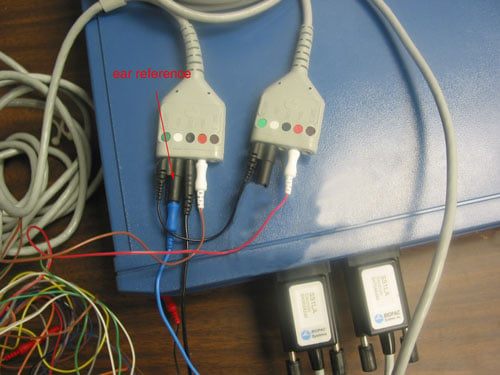Unipolar-EEG
On the MP10x:
For unipolar recording you need as many amplifiers as you have sites to record from. For example, for 16 electrodes (not including 1 reference and 1 ground), you would need 16 EEG amplifiers. For two electrodes (again not including one reference and one ground), you would need two EEG amplifiers. Connect the reference lead (that will typically connect to an electrode on the ear or mastoid bone) to the VIN- of one of the EEG amplifiers. Then, using JUMP100C cables (or JUMP100 cables for B series amplifiers), connect this VIN- to all other VIN- jacks on all EEG amplifiers. Connect one ground only (to any of the EEG amplifiers) to GND. The ground lead can connect to an electrode placed on the forehead, for example. Finally, the lead for each electrode site will connect to the VIN+ of an amplifier.
On the MP3X:
You can have a maximum of four channels for a unipolar EEG setup. One SS1LA is required for each channel. Connect the reference lead (that will typically connect to an electrode on the ear or mastoid bone) to the VIN- of one of the SS1LA. Then, using JUMP100C cables, connect this VIN- to all other VIN- ports on the rest of the SS1LA cables. Connect one ground lead only to GND of one of the SS1LA cables. Finally, the lead for each electrode site will connect to the VIN+ of a SS1LA cable.

Page last modified 19Jan2015
Stay Connected